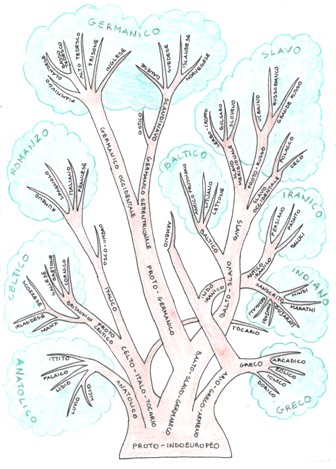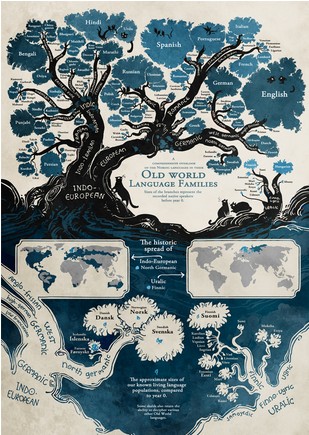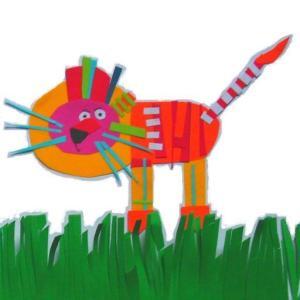LA STORIA DELLE FAMIGLIE LINGUISTICHE fa parte del quadro della QUARTA GRANDE LEZIONE Montessori.
Per approfondire e accedere a tutto il materiale relativo vai qui:
Qui di seguito trovi due versioni del racconto e l’albero linguistico, scaricabile e stampabile in formato pdf.
La storia viene ulteriormente sviluppata in seguito, con la storia delle origini della lingua italiana e con la storia delle origini della lingua inglese.
____________________________

LA STORIA DELLE FAMIGLIE LINGUISTICHE
pdf qui:
QUARTA GRANDE LEZIONE MONTESSORI
LA STORIA DELLE FAMIGLIE LINGUISTICHE
Prima versione
Gli studiosi credono che le lingue attuali siano divise in famiglie. Alcune sono parenti vicine, diciamo sorelle, altre parenti di secondo o terzo grado. Un modo per riconoscere lingue che provengono dalla stessa famiglia linguistica è confrontare le parole che esse usano per chiamare i numeri. Tutti i popoli, infatti, hanno la necessità di contare.
Oggi, circa la metà della popolazione mondiale parla una lingua della famiglia indo-europea, mentre l’altra metà parla lingue di altra provenienza.
La maggior parte delle famiglie linguistiche europee sono legate le une alle altre, ed hanno un’origine comune, una lingua madre chiamata lingua proto-indoeuropea. Le prime persone che parlavano questa lingua, di cui non abbiamo testimonianza, provenivano dalle steppe della Russia, erano pastori nomadi che viaggiavano alla ricerca di pascolo. Si muovevano velocemente perché avevano addomesticato i cavalli, ed avevano carri a ruote trainati da buoi. Come arma avevano delle asce: lo sappiamo perché abbiamo trovato le loro tombe, ed abbiamo scoperto che seppellivano i loro uomini accanto alle loro armi. Le donne venivano sepolte coi loro gioielli d’ambra. Quando questo popolo giunse in Europa, venne in contatto con le popolazioni locali. Si trattava di agricoltori sedentari, che vivevano in villaggi sparsi, e seppellivano i loro morti in grandi tombe megalitiche. Gli uomini con le asce non furono gli unici a raggiungere l’Europa in quel periodo. Abbiamo testimonianze anche del popolo della ceramica campaniforme, proveniente dalla Spagna, che deve questo nome all’uso di fabbricare vasi a forma di campana, e forse conoscevano la tecnica della produzione della birra. Conoscevano anche il bronzo, perché abbiamo trovato coltelli, lance, punte di freccia e gioielli di questo materiale. Probabilmente svolgevano attività di scambio e commercio con gli agricoltori. Questi popoli si mescolarono tra loro, e probabilmente nacque così una lingua comune, che doveva essere il proto-indoeuropeo.
Circa 4.000 anni fa, pare che queste popolazioni cominciarono a muoversi in direzioni diverse, allontanandosi dalle pianure dell’Europa centrale in cui si erano stabiliti in origine. Alcuni si diressero verso Oriente ed altre verso Occidente, e viaggiando incontravano altre popolazioni, che parlavano altre lingue. Così ogni popolazione sviluppò da quella che era una lingua comune, una propria variante. Anche la nostra lingua è nata così.
QUARTA GRANDE LEZIONE MONTESSORI
LA STORIA DELLE FAMIGLIE LINGUISTICHE
Seconda versione
È esistita una lingua uguale per tutti gli uomini, che poi si è diversificata? Da dove viene la nostra lingua? Chi l’ha parlata per primo? Come si sentivano gli uomini quando pronunciarono le prime parole? Quanto tempo fa gli uomini hanno cominciato a parlare? Quando l’Italiano è nato, somigliava a quello che parliamo noi?
Secondo gli studiosi, tutte le lingue europee, persiane e indiane, con poche eccezioni, appartengono ad uno stesso gruppo linguistico. Secondo i Filologi questo gruppo di lingue, chiamato gruppo Indo-europeo, si è diffuso a partire da un punto di origine comune, in un dato momento storico. Si pensa che l’antenato delle lingue indo-europee fosse una lingua parlata da un popolo nomade dedito alla pastorizia, che dalla Russia si spostò verso l’Europa centrale, circa 4.000 anni fa.
Chi erano questi pastori nomadi? Cosa trovarono quando arrivarono in Europa?
Non si sa con certezza, ma si ipotizza che 4.000 anni fa l’Europa fosse un territorio poco popolato, dove gli uomini vivevano divisi in villaggi agricoli (non città). Questi agricoltori erano viaggiatori che via via, provenendo da altre zone, si insediavano dove le condizioni erano più favorevoli all’agricoltura, portando con sé la propria cultura, e i propri usi e costumi. Di questa epoca rimangono le costruzioni megalitiche: grandi tombe funerarie per le sepolture comuni, ad esempio. Probabilmente si dedicavano anche agli scambi e al commercio. Conosciamo una popolazione tra queste, chiamata Cultura del vaso campaniforme, per via dei resti di vasi di ceramica a forma di campana che abbiamo rinvenuto.
Ebbene, tutte queste persone vivevano insieme in modo relativamente pacifico, quando sulla scena irruppe la popolazione dei pastori nomadi di cui abbiamo parlato, e che chiamiamo Popolo dell’Ascia. Il Popolo dell’Ascia si muoveva da un luogo all’altro e non era così pacifica. L’ascia era la loro arma caratteristica: si trattava di asce di guerra fatte di rame o di pietra levigata. Poiché sono state trovate alcune delle loro tombe, sappiamo qualcosa del loro culto dei morti. Nelle loro tombe, gli uomini sono sempre distesi sul fianco destro e con la testa rivolta verso est e i piedi ad ovest. Il volto era girato verso sud, le gambe erano piegate e, nel caso degli uomini, davanti ai loro occhi venivano poste le loro asce. Cercando di interpretare questo modo di seppellire i morti, si è pensato che questi uomini adorassero il sole, ma non ne possiamo essere certi.
Gli studiosi pensano che questi uomini, comunque, parlassero una lingua che può essere l’antenato comune delle lingue indo-europee, chiamata Proto-indoeuropeo, la bisnonna della nostra lingua. Questa popolazione era in grado di muoversi molto velocemente perché aveva addomesticato il cavallo e aveva imparato ad utilizzare la ruota. Costruiva quindi carri trainati da cavalli o da buoi.
LA STORIA DELLE FAMIGLIE LINGUISTICHE
Puoi leggere l’articolo completo qui:
Lapappadolce
Se sei interessato all’argomento, potrebbero interessarti:

THE STORY OF LINGUISTIC FAMILIES It is part of the framework of the MONTESSORI FOUR GREAT LESSON. Below are two versions of the story and the linguistic family tree.
The story is further developed later, with the story of the origins of the Italian language and the history of the origins of the English language.

here: Linguistic Family Tree
MONTESSORI FOUR GREAT LESSON
THE STORY OF LINGUISTIC FAMILIES
First version
Researchers think that the present languages are divided into families. Some are close relatives, say sisters, other relatives of second or third degree. One way to recognize that languages come from the same language family is to compare the words they use to call the numbers. All peoples, in fact, need to count.
Today, about half the world’s population speaks a language of the Indo-European family, while the other half speak languages from other sources.
Most language families in Europe are linked to each other, and have a common origin, a native language called Proto-indoeropean.
The first people who spoke this language, we have not evidence, came from the steppes of Russia, were nomads who traveled in search of grazing. They moved quickly because they had domesticated horses, and had wheeled carts pulled by oxen. As weapons they had axes: we know this because we found their graves, and we found that buried their men next to their weapons. Women were buried with their amber jewelry.
When these people came to Europe, he came into contact with local people. They were sedentary farmers, who lived in scattered villages, and buried their dead in large megalithic tombs.
Men with axes were not the only ones to reach Europe in that period. We have also testimonies of the people of ceramics Belldirectly coming from Spain, so named because manufactured vessels bell-shaped, and perhaps knew the technique beer brewing. Also knew the bronze, because we found knives, spears, arrowheads and jewelry of this material. Probably they held exchange activities and trade with the farmers. These peoples were mingled with each other, and was probably born in this way a common language, which was to be the proto-Indo-European.
About 4,000 years ago, it seems that these people began to move in different directions, moving away from the lowlands of central Europe where they were originally established. Some made their way to the East and the other towards the West, traveling and met other people who spoke other languages. So every population grew from what was a common language, its own variant. Even our language was born in this way.
MONTESSORI FOUR GREAT LESSON
THE STORY OF LINGUISTIC FAMILIES
Second version
It existed a language equal for all men, which later diversified? Where it comes from our language? Who has spoken it first? What men felt when they uttered the first words? How long ago people began to talk? When English is born, it resembled the English that we speak?
According to scientists, all European languages, Persian and Indian, with few exceptions, belong to the same language group. According Philologists this group of languages, called the Indo-European group, has spread from a common point of origin, at a given moment in history. It is thought that the ancestor of the Indo-European languages, was a language spoken by a nomadic people devoted to the sheep, who moved from Russia to Central Europe, about 4,000 years ago.
Who were these nomadic shepherds? What they found when they arrived in Europe?
It is not known with certainty, but it is assumed that 4,000 years ago Europe was a sparsely populated territory, where men lived, divided into agricultural villages (not city). These farmers were travelers who gradually, coming from other areas, came to settle where conditions were more favorable to agriculture, taking with them their culture, and their customs and traditions. Of this time remain the megalithic constructions: big funerary tombs for common burials , for example. Probably they dedicated themselves to trade and commerce. We know a population of these, called Bell Beaker Culture, because of the remains of ceramic pots shaped bell that we found.
Well, all these people lived together relatively peacefully, until the population of nomadic shepherds that we talked about, and we call the People of the Axe, burst onto the scene. The People of the Axe, moving from place to place and it was not so peaceful. The ax was their characteristic weapon: it was axes of war made of copper or polished stone. For we have found some of their graves, we know something of their cult of the dead. In their graves, the men are always lying on his right side with the head turned towards east and feet turned towards west. The face was turned towards the south, the legs were bent and, in the case of men, before their eyes were put their axes. Trying to interpret this way of burying the dead, the scientists thought that these men should worship the sun, but we can not be certain.
Researchers think that these men, however, spoke a language which can be the common ancestor of the Indo-European languages, called Proto-indoeropeo, the great-grandmother of our language. This population was able to move very quickly because he had tamed the horse and had learned to use the wheel. Then built carts pulled by horses or oxen.

